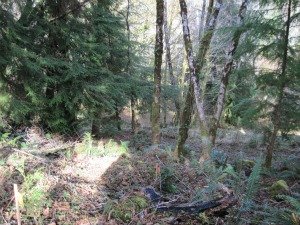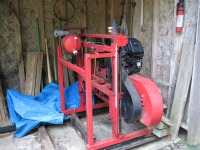Bandsaw Sawmill you can use to Saw Lumber from your Timber

Bandsaw sawmill you can use to saw lumber from timber on your forestry garden.
This saw works especially well on the hardwood timber that you may have.
I have one of these and it is a basic type so a lot of the operation is of the manual nature.
This doesn't bother me as I am not out to make production with this machine.
I take my time and get as much return out of the logs as I can.

A mill of this sort depends upon the blade holding true as it passes thru the log to cut a board.
The blade is very thin and it doesn't take much to get it to move either up or down.
When this happens the board will be cut either thick or thin.
If you are making finished lumber material this will not normally be a big factor, unless the cut varies a great deal.
The boards are usually oversized enough to compensate for this.
It is extremely difficult to make a number of cuts without some variation.
One thing that can help is to make sure the blade is super sharp and set correctly for the type of material being cut.
This bandsaw sawmill uses what is known as disposable blades.
They are fairly cheap and there are those that throw them away when they get dull.
I do not think this way.
I re-sharpen my blades a number of times.
The blade will travel around the wheels only a number of times until it will break.
When this happens it does have a tendency to get your attention.
Fortunately the mills have guards to protect you from getting hurt.
Another thing that will make your saw stray is the grain in the timber you are cutting.
A very severe grain can and does pull the blade one way or the other.
This makes the board have a thick or thin spot.
If the blade is pulled to extreme it can come off the guides and damage the blade.
The speed of feed does have a factor in the quality of lumber produced.
My bandsaw sawmill is a manual feed so I can easily vary the feed rate.
All mills have some method of doing this.
When you come in contact with a large knot it is a good idea to slow down the feed rate.
The blades on these machines are prone to getting dull when coming in contact with foreign material.
Dirt and rocks will make the teeth dull in just a short period of time.
The cleaner the timber from your forestry garden is before you saw it the longer the blade will stay sharp.
It takes time to either replace the blade or re-sharpen it so some time spent on cleaning the logs before sawing is time well spent.
There are a number of different types of saw mills on the market today.
The old proven rule of money to effort applies here as most other places.
The more money you have to spend on one of these the less effort you will have to expend to get lumber from your hardwoods.
These mills are capable of sawing most any dimension of lumber and logs up to three feet or so in diameter.
You must be prepared to put out some effort when using one of these saw mills.
It is necessary to reposition the log on the deck a number of times before you can produce a board.
This does give you the opportunity to get some exercise.
If the logs are large you will need to use some sort of extra helper to turn it.
This applies only with the manual mill.
When sawing the large diameter logs it does take some maneuvering on your part to accomplish this.
I would recommend that you start out on the smaller logs until you are comfortable with the operation.
When you get to where you feel you have mastered it then would be the time to tackle a larger log.
The blade used on the bandsaw sawmill needs some sort of lubrication on it to make it cut better and with a longer life.
I have tried different products and have settled on the proven one.
Water is cheap and clean and for the type of lumber I am making from my timber it works well.
I do drain the system when I am putting the mill away for a period of time.
This is especially important to do in the winter when the temperature is lower.
You can take a bandsaw sawmill and turn your timber from your forestry garden into lumber that you can use to make finished projects.
It is a comforting feeling to realize that you have made this fine piece of lumber.
You did this by your effort and skill.
Now that you have your lumber produced there are more steps to take before you can use it on a project.
Check out the lumber drying page.
There is one item that does slow down production. Dirty logs. If you want to be able to protect your blade from foreign material that is on the log you will need to use a Log DeBarker. Go to the following site to get the needed information on this tool:
From bandsaw sawmill to lumber production
From bandsaw sawmill to forestry gardening tips
Click here to read our privacy policy: Privacy Policy





